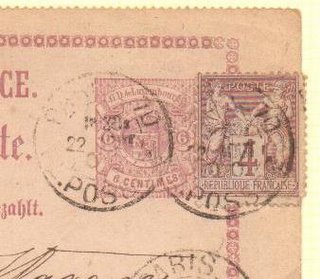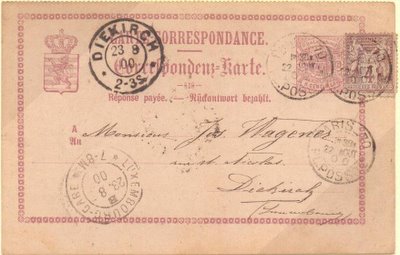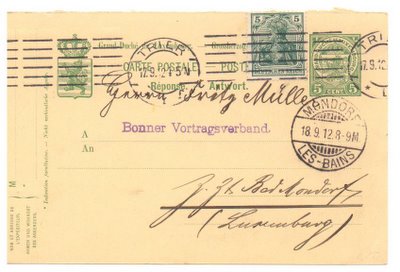Postal cards with a paid reply were introduced to the international mails by the UPU Congress held in Lisbon in 1885. Sometimes called “double” or “message-reply” cards, they are the bete noire of postal stationery collectors, especially those who aspire to exhibit internationally.
UPU members were not obligated to issue reply-paid postal cards, but they were required to return reply-paid cards received from other UPU countries. The reply card of a message-reply card could only be returned to its country of origin. Privately printed reply-paid cards were also permitted, provided that the country of origin allowed them and they conformed in shape and thickness with the postal cards issued by the country of origin. In practically every case, the reply-paid card cost double the price of the corresponding single card. Where a reduced or treaty rate existed between two countries, the reply-paid card rate was similarly reduced. Both the message card and reply card were to be fully prepaid at the time of mailing; otherwise, they were not to be dispatched. Printing of text by the sender on the back of the reply card, such as a questionnaire to be filled out by the addressee, was permitted. International reply-paid postal card service was discontinued by the Tokyo UPU Congress in November, 1969, effective July 1, 1971.
Given these parameters, how then would it have been possible for cards to be returned with mixed franking (i.e., franking of the both the origin and destination countries)? The examples below demonstrate that such mixed franking indeed did occur and that when it did, no penalty was assessed.
Example 1: Luxembourg-France-Luxembourg (1900)

The 6-centime reply card seen here from Luxembourg’s Second Arms Issue 6-centime+6-centime message-reply card [Prifix No. 6] paid the special treaty rate to Germany when it was issued in 1874, 11 years before international reply-paid postal cards were introduced into the UPU. However, it was not used until August 22, 1900, when it was returned from Paris, France to Diekirch via Luxembourg-Gare on August 23rd. By that time, a uniform ten-centime UPU postal card rate had gone into effect. Consequently, the sender added a French four-centime Allegory stamp to up-rate the card to the then current ten-centime rate!

Example No. 2: Luxembourg-France-Luxembourg

Reply card from the five-centime G.D. William IV message-reply card [Prifix 55] up-rated to ten-centimes with a French five-centime Allegory adhesive and returned from Tours-Gare, France, March 18, 1898 to Luxembourg-Ville, March 19, 1898.

Example 3: Austria-Luxembourg-Austria (1909)

The five-heller Austrian reply card [Michel No. P198] seen here was returned from Wecker, Luxembourg, on May 18, 1909, when Austria’s UPU rate was ten hellers. To make up the deficiency, a five-centime Luxembourg Écusson definitive [Prifix No. 92] was added, and the card returned to Vienna, Austria, without penalty.

Example 4: Luxembourg-Germany-Luxembourg (1912)

The five-centime reply card seen here from Luxembourg’s 20th century Écusson issue [Prifix No. 64] was returned from Trier, Germany, September 17, 1912, to Mondorf-les-Bains, Luxembourg, the following day. Since a ten-centime treaty rate had been in effect since 1902 from Luxembourg to Germany, a five-pfenning German adhesive was added, and the card was returned without penalty.

No comments:
Post a Comment